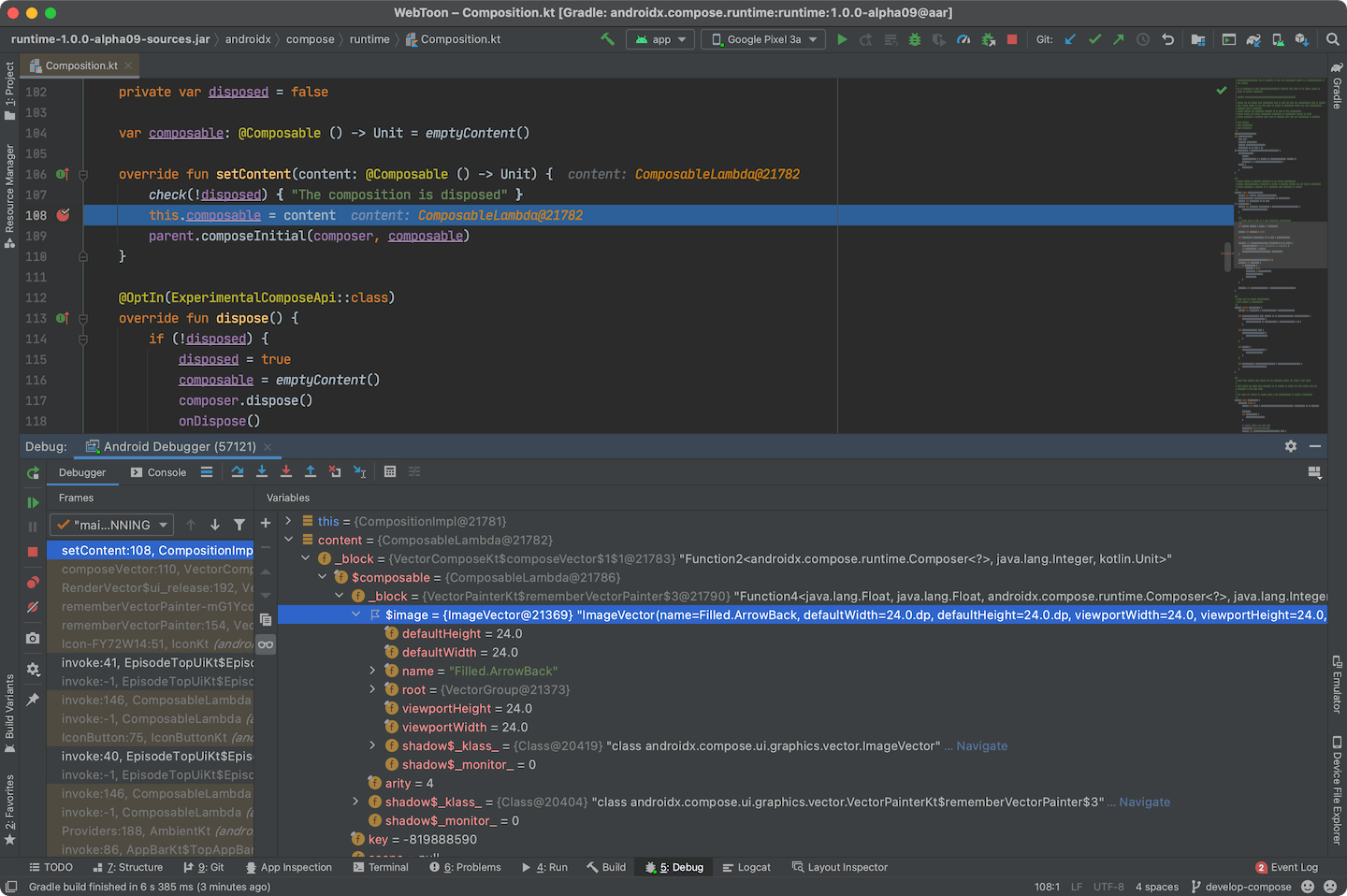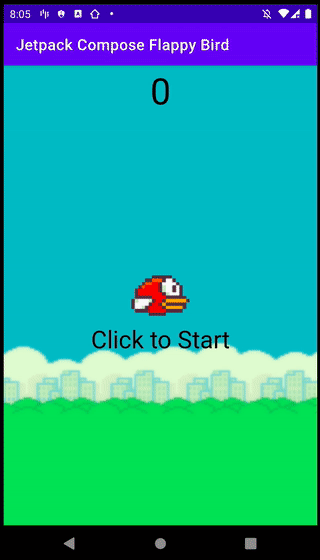Jetpack Compose 공부 ~ 7주차
본 글은 개인적으로 Jetpack AndroidX Compose의 스터디한 내용을 정리하는 아카이브용입니다.
지극히 개인적인 의견입니다.
테스트 전제 조건
- Android Studio Arctic Fox | 2020.3.1 Canary 3
- Jetpack Compose 1.0.0-alpha08
실험하는 소스 : https://github.com/Pluu/WebToon/compare/develop-compose
1. compose alpha09
https://developer.android.com/jetpack/androidx/versions/all-channel#december_16_2020
Transition V2
- https://android-review.googlesource.com/c/platform/frameworks/support/+/1516022
Deprecated : LazyColumnFor, LazyRowFor, LazyColumnForIndexed and LazyRowForIndexed → LazyColumn, LazyRow
- https://android-review.googlesource.com/#/q/I5b48c8a3b1fef2f603ab69ded1d19709aa9f87fb
Added, LazyVerticalGrid
- https://android-review.googlesource.com/c/platform/frameworks/support/+/1480539
Added, androidx.compose.material:material-ripple
Renamed *Constants objects such as ButtonConstants to end with Defaults instead, such as ButtonDefaults. Also removes unnecessary default prefixes from properties in these new objects
- https://android-review.googlesource.com/c/platform/frameworks/support/+/1515511
2. Activity/Fragment에서의 Compose 객체에 생명주기 연결 흐름
fun ComponentActivity.setContent(
// Note: Recomposer.current() is the default here since all Activity view trees are hosted
// on the main thread.
parent: CompositionReference = Recomposer.current(),
content: @Composable () -> Unit
): Composition {
GlobalSnapshotManager.ensureStarted()
val composeView: AndroidComposeView = window.decorView
.findViewById<ViewGroup>(android.R.id.content)
.getChildAt(0) as? AndroidComposeView
?: AndroidComposeView(this).also {
setContentView(it.view, DefaultLayoutParams)
}
return doSetContent(composeView, parent, content)
}
@Deprecated("Use ComposeView or AbstractComposeView instead.")
fun ViewGroup.setContent(
parent: CompositionReference = Recomposer.current(),
content: @Composable () -> Unit
): Composition {
GlobalSnapshotManager.ensureStarted()
val composeView =
if (childCount > 0) {
getChildAt(0) as? AndroidComposeView
} else {
removeAllViews(); null
} ?: AndroidComposeView(context).also { addView(it.view, DefaultLayoutParams) }
return doSetContent(composeView, parent, content)
}
https://github.com/androidx/androidx/blob/androidx-main/compose/ui/ui/src/androidMain/kotlin/androidx/compose/ui/platform/Wrapper.kt#L130
internal class AndroidComposeView(context: Context) :
ViewGroup(context), Owner, ViewRootForTest {
...
override fun onAttachedToWindow() {
super.onAttachedToWindow()
...
if (viewTreeOwners == null) {
val lifecycleOwner = ViewTreeLifecycleOwner.get(this) ?: throw IllegalStateException(
"Composed into the View which doesn't propagate ViewTreeLifecycleOwner!"
)
val viewModelStoreOwner =
ViewTreeViewModelStoreOwner.get(this) ?: throw IllegalStateException(
"Composed into the View which doesn't propagate ViewTreeViewModelStoreOwner!"
)
val savedStateRegistryOwner =
ViewTreeSavedStateRegistryOwner.get(this) ?: throw IllegalStateException(
"Composed into the View which doesn't propagate" +
"ViewTreeSavedStateRegistryOwner!"
)
val viewTreeOwners = ViewTreeOwners(
lifecycleOwner = lifecycleOwner,
viewModelStoreOwner = viewModelStoreOwner,
savedStateRegistryOwner = savedStateRegistryOwner
)
this.viewTreeOwners = viewTreeOwners
onViewTreeOwnersAvailable?.invoke(viewTreeOwners)
onViewTreeOwnersAvailable = null
}
viewTreeObserver.addOnGlobalLayoutListener(globalLayoutListener)
viewTreeObserver.addOnScrollChangedListener(scrollChangedListener)
}
}
https://github.com/androidx/androidx/blob/androidx-main/compose/ui/ui/src/androidMain/kotlin/androidx/compose/ui/platform/AndroidComposeView.kt#L599
private class WrappedComposition(
val owner: AndroidComposeView,
val original: Composition
) : Composition, LifecycleEventObserver {
private var disposed = false
private var addedToLifecycle: Lifecycle? = null
private var lastContent: @Composable () -> Unit = emptyContent()
@OptIn(InternalComposeApi::class)
override fun setContent(content: @Composable () -> Unit) {
owner.setOnViewTreeOwnersAvailable {
if (!disposed) {
val lifecycle = it.lifecycleOwner.lifecycle
lastContent = content
if (addedToLifecycle == null) {
addedToLifecycle = lifecycle
// this will call ON_CREATE synchronously if we already created
lifecycle.addObserver(this)
} else if (lifecycle.currentState.isAtLeast(Lifecycle.State.CREATED)) {
original.setContent {
@Suppress("UNCHECKED_CAST")
val inspectionTable =
owner.getTag(R.id.inspection_slot_table_set) as?
MutableSet<CompositionData>
?: (owner.parent as? View)?.getTag(R.id.inspection_slot_table_set)
as? MutableSet<CompositionData>
if (inspectionTable != null) {
@OptIn(InternalComposeApi::class)
inspectionTable.add(currentComposer.compositionData)
currentComposer.collectParameterInformation()
}
LaunchedEffect(owner) { owner.keyboardVisibilityEventLoop() }
LaunchedEffect(owner) { owner.boundsUpdatesEventLoop() }
Providers(InspectionTables provides inspectionTable) {
ProvideAndroidAmbients(owner, content)
}
}
}
}
}
}
override fun dispose() {
if (!disposed) {
disposed = true
owner.view.setTag(R.id.wrapped_composition_tag, null)
addedToLifecycle?.removeObserver(this)
}
original.dispose()
}
override fun hasInvalidations() = original.hasInvalidations()
override fun onStateChanged(source: LifecycleOwner, event: Lifecycle.Event) {
if (event == Lifecycle.Event.ON_DESTROY) {
dispose() // <-- DESTROY 시점에 dispose()
} else if (event == Lifecycle.Event.ON_CREATE) {
if (!disposed) {
setContent(lastContent)
}
}
}
}
https://github.com/androidx/androidx/blob/androidx-main/compose/ui/ui/src/androidMain/kotlin/androidx/compose/ui/platform/Wrapper.kt#L223
3. Sub-Compose 생성 흐름
Public UI Foundation (Scaffold, LazyList … )
↓
SubcomposeLayout
↓
SubcomposeLayoutState#subcompose
private fun subcompose(node: LayoutNode, nodeState: NodeState) {
node.ignoreModelReads {
val content = nodeState.content
nodeState.composition = subcomposeInto(
container = node,
parent = compositionRef ?: error("parent composition reference not set"),
// Do not optimize this by passing nodeState.content directly; the additional
// composable function call from the lambda expression affects the scope of
// recomposition and recomposition of siblings.
composable = { content() }
)
}
}
↓
/**
* @param parent An optional reference to the parent composition.
* @param composerFactory A function to create a composer object, for use during composition
* @param onDispose A callback to be triggered when [dispose] is called.
*/
private class CompositionImpl(
private val parent: CompositionReference,
composerFactory: (CompositionReference) -> Composer<*>,
private val onDispose: () -> Unit
) : Composition {
private val composer: Composer<*> = composerFactory(parent).also {
parent.registerComposer(it)
}
/**
* Return true if this is a root (non-sub-) composition.
*/
val isRoot: Boolean = parent is Recomposer
private var disposed = false
var composable: @Composable () -> Unit = emptyContent()
override fun setContent(content: @Composable () -> Unit) {
check(!disposed) { "The composition is disposed" }
this.composable = content
parent.composeInitial(composer, composable)
}
@OptIn(ExperimentalComposeApi::class)
override fun dispose() {
if (!disposed) {
disposed = true
composable = emptyContent()
composer.dispose()
onDispose()
}
}
override fun hasInvalidations() = composer.hasInvalidations()
}

↓
Composer#composeInitial
↓
internal fun invokeComposable(composer: Composer<*>, composable: @Composable () -> Unit) {
@Suppress("UNCHECKED_CAST")
val realFn = composable as Function2<Composer<*>, Int, Unit>
realFn(composer, 1)
}
Sample Code
StaggeredVerticalGrid
- https://github.com/android/compose-samples/blob/main/Owl/app/src/main/java/com/example/owl/ui/courses/FeaturedCourses.kt#L171
Article
[Compose Snippet] Parallax Scroll 🏙
- https://medium.com/@theRoshogulla/compose-snippet-parallax-scroll-3bd987a5f8f3
Reference
- https://developer.android.com/reference/kotlin/androidx/compose/foundation/package-summary#horizontalscroll
- 콘텐츠 너비가 최대 제약 조건에서 허용하는 것보다 큰 경우 가로로 스크롤 할 수 있도록 요소를 수정
import androidx.compose.foundation.background
import androidx.compose.foundation.horizontalScroll
import androidx.compose.foundation.layout.Box
import androidx.compose.foundation.layout.size
import androidx.compose.foundation.rememberScrollState
import androidx.compose.ui.graphics.HorizontalGradient
val scrollState = rememberScrollState()
val gradient = HorizontalGradient(
listOf(Color.Red, Color.Blue, Color.Green), 0.0f, 10000.0f, TileMode.Repeated
)
Box(
Modifier
.horizontalScroll(scrollState)
.size(width = 10000.dp, height = 200.dp)
.background(brush = gradient)
)
원본 소스 : https://developer.android.com/reference/kotlin/androidx/compose/foundation/package-summary#horizontalscroll
[Android Jetpack Compose Flappy Bird]
- https://elye-project.medium.com/android-jetpack-compose-flappy-bird-9ac4b1d223df

- 원본 소스 : https://github.com/elye/demo_android_jetpack_compose_flappy_bird
Subscribe
Subscribe to this blog via RSS.
Categories
Recent Posts
- Posted on 30 Dec 2025
- Posted on 11 Oct 2025
- Posted on 27 Aug 2025
-
[발표자료] Google I/O Extended Incheon 2025 ~ What's new in Android development tools
Posted on 16 Aug 2025